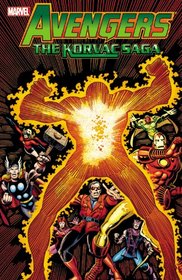"The Korvac Saga" first appeared in single-issue format in 1978. I was able in my teens to buy some of the individual issues at comic conventions, but never read the entire story until recently.
It's disappointing.
In all fairness, comic books in 1978 had a younger readership than they do in 2013, and so you have to expect that they're going to focus on adventure and spectacle more than on the humanity of their characters. That is particularly true for comics about superhero teams with rosters with legends like Captain America, powerhouses like Iron Man and Wonder Man, and the occasional Norse or Greek god.
But to a 42-year-old who still finds something to enjoy in superhero comics, this comic did disappoint. There are too many clumsy asides, to bring the reader up to pace on what happened last issue; too many people casually walking around in public or in the privacy of their own home in silly costumes; and too much melodrama to make sure we know just how powerful and menacing a figure Michael Korvac cuts. (Korvac was the creation of Jim Shooter, and one of many of the nemeses he created for Marvel whose godlike powers were so tremendous that he was virtually undefeatable -- except of course, the heroes always manage to find a way.).
And then there are other things that just feel odd. Never in my life did I expect to see Captain America and Iron Man squabbling like children, but that's a spectacle that awaits inside this volume. "It's my turn to be in charge and give the orders!" Iron Man whines. "But you're doing it wrong!" Captain America shouts, before punching him in the face. (No, I am not making that up.)
That's not to say the comic was awful, though, because it wasn't. If the story seems too juvenile at times, there are moments when the writer's wit shines through. There's the fashion show hosted by the Wasp, that gets crashed by a supervillain wannabee wearing a suit made of brown projectile quills and calling himself the Porcupine. Or there's the moment when the Avengers realize, their special flight privileges revoked, that they have to take a bus to Queens to save the world.
The story's got some of the great Marvel cliches, like a threat to the entire universe, but it also uses some of the storytelling techniques that have made Marvel Comics worth reading for so long, such as the use of a subplot involving the Collector that finally reveals its relationship to the larger story just as the subplot concludes. And of course, this is the story that gave us Henry Gyrich, the government agent whom every superhero is afraid of.
All told, I enjoyed the story for what it is, though I'd be lying if I said I didn't skim it at times. On the other hand, my daughters, who still love a good superhero romp as much I once did, have been enjoying it quite a bit.
It's disappointing.
In all fairness, comic books in 1978 had a younger readership than they do in 2013, and so you have to expect that they're going to focus on adventure and spectacle more than on the humanity of their characters. That is particularly true for comics about superhero teams with rosters with legends like Captain America, powerhouses like Iron Man and Wonder Man, and the occasional Norse or Greek god.
But to a 42-year-old who still finds something to enjoy in superhero comics, this comic did disappoint. There are too many clumsy asides, to bring the reader up to pace on what happened last issue; too many people casually walking around in public or in the privacy of their own home in silly costumes; and too much melodrama to make sure we know just how powerful and menacing a figure Michael Korvac cuts. (Korvac was the creation of Jim Shooter, and one of many of the nemeses he created for Marvel whose godlike powers were so tremendous that he was virtually undefeatable -- except of course, the heroes always manage to find a way.).
And then there are other things that just feel odd. Never in my life did I expect to see Captain America and Iron Man squabbling like children, but that's a spectacle that awaits inside this volume. "It's my turn to be in charge and give the orders!" Iron Man whines. "But you're doing it wrong!" Captain America shouts, before punching him in the face. (No, I am not making that up.)
That's not to say the comic was awful, though, because it wasn't. If the story seems too juvenile at times, there are moments when the writer's wit shines through. There's the fashion show hosted by the Wasp, that gets crashed by a supervillain wannabee wearing a suit made of brown projectile quills and calling himself the Porcupine. Or there's the moment when the Avengers realize, their special flight privileges revoked, that they have to take a bus to Queens to save the world.
The story's got some of the great Marvel cliches, like a threat to the entire universe, but it also uses some of the storytelling techniques that have made Marvel Comics worth reading for so long, such as the use of a subplot involving the Collector that finally reveals its relationship to the larger story just as the subplot concludes. And of course, this is the story that gave us Henry Gyrich, the government agent whom every superhero is afraid of.
All told, I enjoyed the story for what it is, though I'd be lying if I said I didn't skim it at times. On the other hand, my daughters, who still love a good superhero romp as much I once did, have been enjoying it quite a bit.




